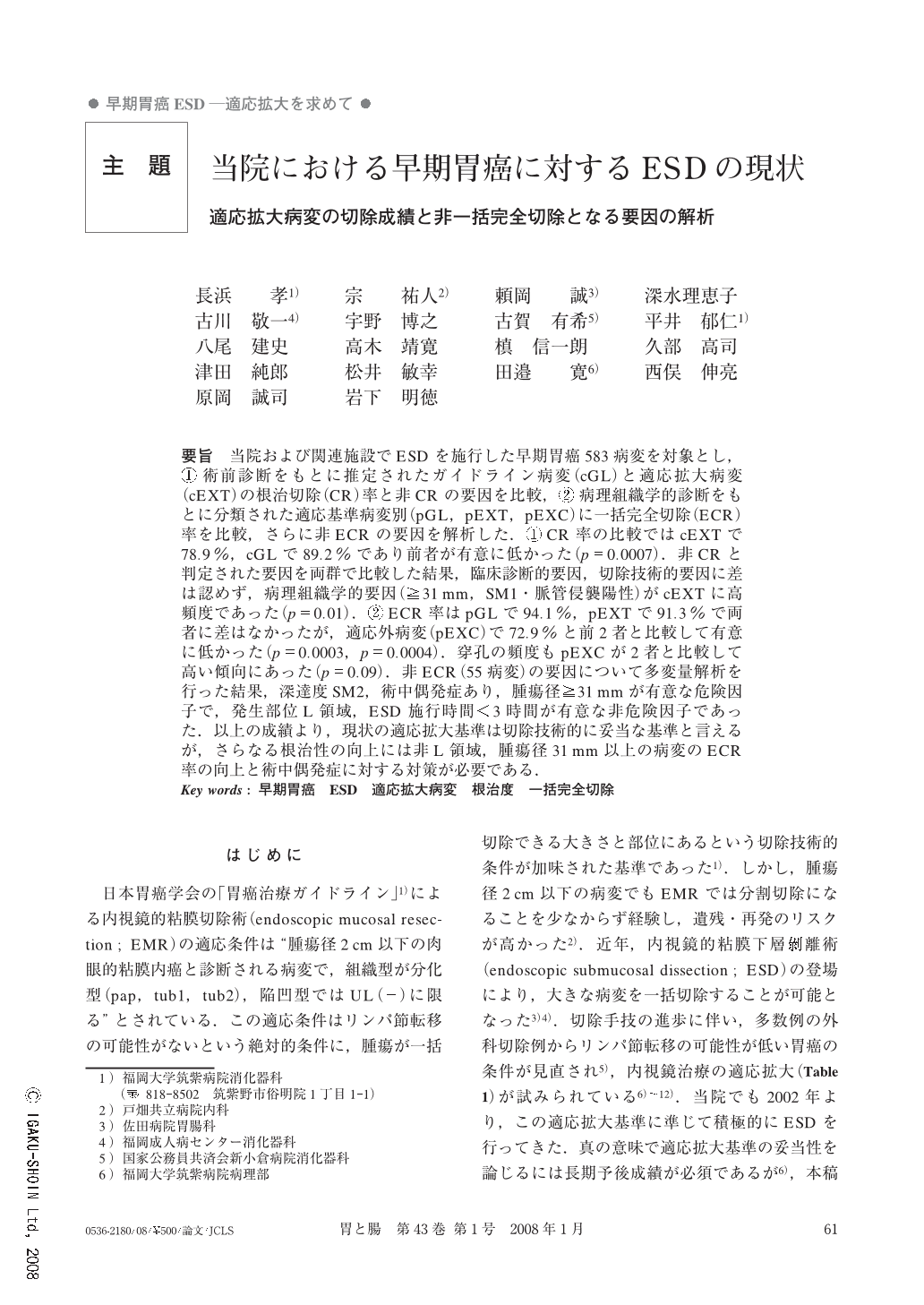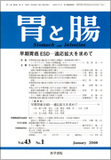Japanese
English
- 有料閲覧
- Abstract 文献概要
- 1ページ目 Look Inside
- 参考文献 Reference
- サイト内被引用 Cited by
要旨 当院および関連施設でESDを施行した早期胃癌583病変を対象とし,①術前診断をもとに推定されたガイドライン病変(cGL)と適応拡大病変(cEXT)の根治切除(CR)率と非CRの要因を比較,②病理組織学的診断をもとに分類された適応基準病変別(pGL,pEXT,pEXC)に一括完全切除(ECR)率を比較,さらに非ECRの要因を解析した.①CR率の比較ではcEXTで78.9%,cGLで89.2%であり前者が有意に低かった(p=0.0007).非CRと判定された要因を両群で比較した結果,臨床診断的要因,切除技術的要因に差は認めず,病理組織学的要因(≧31mm,SM1・脈管侵襲陽性)がcEXTに高頻度であった(p=0.01).②ECR率はpGLで94.1%,pEXTで91.3%で両者に差はなかったが,適応外病変(pEXC)で72.9%と前2者と比較して有意に低かった(p=0.0003,p=0.0004).穿孔の頻度もpEXCが2者と比較して高い傾向にあった(p=0.09).非ECR(55病変)の要因について多変量解析を行った結果,深達度SM2,術中偶発症あり,腫瘍径≧31mmが有意な危険因子で,発生部位L領域,ESD施行時間<3時間が有意な非危険因子であった.以上の成績より,現状の適応拡大基準は切除技術的に妥当な基準と言えるが,さらなる根治性の向上には非L領域,腫瘍径31mm以上の病変のECR率の向上と術中偶発症に対する対策が必要である.
The study was conducted on lesions in 583 patients with early stomach cancer who underwent ESD at our hospital or affiliated institutions. The study consisted of the following two parts:(1) The rate of complete resection (CR) of the guideline lesions (cGL) presumed according to pre-operative diagnosis and the lesions eligible under the extended indications (cEXT), as well as non-CR factors of these groups, were compared;and (2) The lesions compared were classified according to an adaptive standard based on the histopathological diagnosis and the rate of en bloc complete resection (ECR). In addition, factors for non-ECR were analyzed. (1) The rate for CR was 78.9% for cEXT and 89.2% for cGL, with the former being significantly lower (p=0.0007). When the two groups were compared for the factors that led to the judgment of non-CR, no difference was found between the clinical diagnosis or in the resectional technology;but a pathological factor (vascular invasion, ≧31mm, SM1) was found more frequently in cEXT (p=0.01). (2) The rate of ECR was 94.1% for pGL and 91.3% for pEXT, with no difference between the two. However, it was 72.9% for the lesions excluded from the indications (pEXC), which was significantly lower than the other two (p=0.0003 and p=0.0004). The frequency of perforation for pEXC was significantly higher than the other two(p=0.09). A multivariate analysis was conducted for the factor involving non-ECR (55 lesions). The depth of tumor invasion was SM2 with the development of intra-operative complications. A tumor diameter of ≧31mm is a significant risk factor, while the L region for the site of development and a duration of ESD of<3 hours were significant non-risk factors. These findings indicated that the current standard for adaptive extension is appropriate in the light of excisional technology but for further improvement in the rate of radical cure, amelioration of the ECR rate for those lesions measuring more than 31mm in tumor diameter and measures to counteract intra-operative complications are necessary.

Copyright © 2008, Igaku-Shoin Ltd. All rights reserved.


